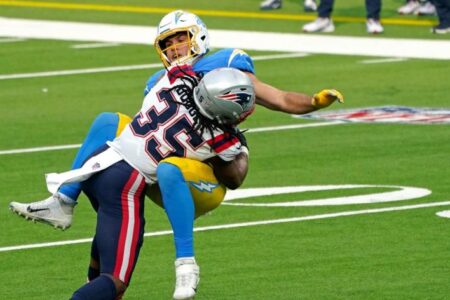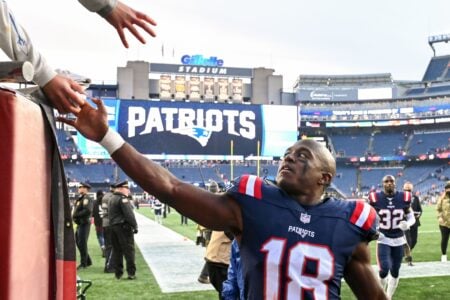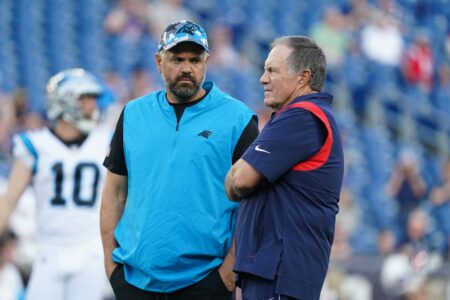- Joined
- Dec 18, 2004
- Messages
- 12,748
- Reaction score
- 22,812
Registered Members experience this forum ad and noise-free.
CLICK HERE to Register for a free account and login for a smoother ad-free experience. It's easy, and only takes a few moments.Iceland was part of Denmark until 1944Hello from Iceland
No. Also, Deion Branch had 10/143/TD…not Troy Brown.Troy Brown >>> Steve Tasker (who gets HOF votes)
Extremely biased view of course but I think a case can be made that Troy Brown had a better career than Tim Brown, who is in. I liked Tim Brown and think he deserved to be elected, though it surely wasn't a no brainer, but Troy did more to contribute to victories and championships than Tim, with due respect to the fact that Tim played for a lunatic owner that had lost his football acumen before Tim ever showed up.
They certainly don't win Super Bowl XXXVI without him and given the way the game played out I don't think they win Super Bowl XXXVIII without him (10 receptions from 13 targets, 143 yards, 1 TD).
Pretty sure 1776 is longer ago than 1918.Hello from Iceland
More to the point Iceland wasn't a sovereign state until 1944 when they got their Independence from Denmark. The US is the *country* with the oldest continuous democracy.Pretty sure 1776 is longer ago than 1918.
Tim Brown had twice as many receptions for 2 1/2 times as many yards and 100 TDs vs 31. 15000 yards to 6400 is night and day.Troy Brown >>> Steve Tasker (who gets HOF votes)
Extremely biased view of course but I think a case can be made that Troy Brown had a better career than Tim Brown, who is in. I liked Tim Brown and think he deserved to be elected, though it surely wasn't a no brainer, but Troy did more to contribute to victories and championships than Tim, with due respect to the fact that Tim played for a lunatic owner that had lost his football acumen before Tim ever showed up.
They certainly don't win Super Bowl XXXVI without him and given the way the game played out I don't think they win Super Bowl XXXVIII without him (10 receptions from 13 targets, 143 yards, 1 TD).
But the US didn't allow their women or blacks to vote for many decades. That's not a true democracy.More to the point Iceland wasn't a sovereign state until 1944 when they got their Independence from Denmark. The US is the *country* with the oldest continuous democracy.
Their parliament was in power from 930 for 300 years, and was re-established in the last century.Iceland was part of Denmark until 1944

So by that measure Athens is the oldest democracy -- or more likely some obscure city state or village lost to time so no one remembers.Their parliament was in power from 930 for 300 years, and was re-established in the last century.

History of Iceland - Wikipedia
en.wikipedia.org
Not to change the subject, because all the good Iceland talk is actually WHY I come here, but I wonder if anyone knows where Trey Flowers is on his knee rehab. I'm pretty sure that's the reason why his name has disappeared from any FA talk around the league. Of course on the surface coming back to the Pats where he had his greatest successes makes a lot of sense for both parties. It would end the all the question marks going into the season about who will provide the rush opposite Judon this season. It would also create enough depth in a rotation so Judon won't burn out a the end of the season.
On the other hand, he was supposed to earn $16MM this season and HALF that amount might be too much for the Pats to absorb. OTOH, I'd be OK with $4MM guaranteed with $2MM in incentives for things like games played and defensive snaps, things that would be considered likely to be gotten, and $2MM in things like individual awards and team success which are more iffy.
Flowers didn't have the same success he had in NE AND comes in to any team with a knew injury that isn't still a full strength after almost 6 months after the injury
A quick google search I saw an article that mentioned the Pats, LV, Packers, and Panthers are likely landing spots for Trey, so in the end it might be just a matter of how much money a team is willing or able to provide.
Some really really good stuff here. Some of it I've been preaching "the draft is really only 4 rounds, not much difference between RD5-UDFA" ... this piece might suggest I'm off by a round and it's really only 3 rounds. Honestly we'll worth the read I'll be linking more stuff but this is some good insight into different spaces of team building.What's you opinion on the draft and how you should go about using picks?? It drives me crazy when people say "it's a crapshoot" even though it really is. The problem with that saying is people aren't thinking of the strict definition which is basically "risky", taking a risk. Absolutely. Most drscribe it as youre throwing darts blindfolded. Every pick comes with a little gamble, for sure. As much as I believe in myself and others when it comes to scouting and evaluation. Trying to predict what young people will do is an extremely difficult and an often thankless task. Very few are objective, open minded and patient enough to really assess or critique someone's work. There's still a lot of darkness to in that particular department - who's actually good.
Pro football reference has their AV score that Schultz came up with. We hear all the time that half the picks bust. 55% for the 1st and 50% for the 2nd is what I last remember? I'm sure it's close to the if I'm off. I just came across more info from a recent article by the 33rd team that only 30% of 1st RD picks sign a second contract with the team that drafted them. That's pretty eye opening and would absolutely cause me to think about how I want to allocate my picks. Especially early round picks bc they tend to matter the most. Or one would think. The middle to late rounds might actually be the money balls bc those contracts are so similar and as well as the prospect you're getting.
If I'm a team. Especially one like the Rams or Bills I'd be seriously thinking about this as a way to allocate their picks. Or even dare I say, trade UP for a prospect that's in or closer to that elite/top tier. Here's the thing you're looking for a surer thing with all these picks. 1st & 2nd RD. You want to eliminate as much risk as possible. You don't want a 50/50 gamble with a prospects & why draft a prospect that might take time to develop when you can have a sure thing in an established NFL player.
I just think that's some info that should make think twice and definitely explore all options.
I'll post the link when I can it's somewhere saved and I'm taking a quick break from family but it's definitely a worthwhile read. Happy 4th! @Mike the Brit enjoy your independence and a "your welcome" from the states!
FWIW no knee brace...
I posted that article in the 2022 NFL Free Agency thread and there was some discussion there. There's 4 parts to it. Useful analysis. It goes on to look at the SCPR by position. It points out that drafting a Guard in the 1st round is not a good investment. That's one of the issues I had with the Strange pick. If I recall QB, WR, CB, Edge & T were better picks in the 1st round by their metrics.Some really really good stuff here. Some of it I've been preaching "the draft is really only 4 rounds, not much difference between RD5-UDFA" ... this piece might suggest I'm off by a round and it's really only 3 rounds. Honestly we'll worth the read I'll be linking more stuff but this is some good insight into different spaces of team building.
@WaterfallJumper and other draftniks might love this ****t
What data was used?
A comprehensive database was built using Pro Football Focus’ draft data with Over the Cap’s contract data to understand the difference between draft picks’ first contracts and their second contracts if they receive one. The draft data is from 2010-2017. Recent years were excluded to not generate inaccurate insights due to the picks still being on their rookie contracts.
How do we define success?
Determining a successful draft pick is both objective and subjective. Viewing it from a purely nominal value, a metric was calculated to determine a successful pick. This metric is known as the SC Pay Ratio, which refers to the second contract pay ratio. It takes the amount of money guaranteed in the second contract and compares it to the guaranteed money from the first contract.
In general, a player receiving more guaranteed money in their second contract has performed better than their pick position suggests. The data is broken down into whether the second contract comes from the same team or an alternative team.
The three largest groups that share the greatest proportion of the same result lie in the picks from round one to round three whose second contracts come with different teams. This is 50% of round one picks, 43% of round two picks, and 32% of round three picks
The 4th greatest proportion (31%) is those round one picks whose second contract came from the same team
It’s evident from the above graph that the league’s largest second contracts go to those who were drafted in the first round and get signed to an extension by the same team. As previously mentioned, this is 31% of round one picks, which indicates that about one in three picks from the first round will be signed to a second contract with the same team. This is the first indicator of a successful first round pick and might be quite alarming that only one in three appear to work out.
The guaranteed money for those round one picks getting their second contracts with the same team is just under forty million, which almost doubles the next highest grouping which is just under twenty million (the round two picks that sign with the same team).
Round three players signing with the same team tend to be valued at the same price as round one players signing with a different team (15.7 million vs. 16.2 million, respectively)
What is particularly interesting to note is that fifth round picks who re-sign with the same team outperformed round four picks who re-signed with the same team in terms of guaranteed money in their second contracts. This also occurred with rounds seven and six. What this suggests is that there is a drop off after round three where there is not much of a difference between a fourth round pick and seventh round pick.
Rounds one and two tend to offer the least value since the initial rookie contracts guarantee quite a lot of money for people that have never taken a snap in the NFL. This actually suggests that there is a market inefficiency which benefits those players over the teams. Only 30% of the round one picks will get a second contract with the same team (in essence, the best case scenario for the team correlating with a good pick)
The average SC Pay Ratio for a player picked in round one is 1.90. This is a score performing only slightly above the expected for the round they were picked in. It states that although the best players (or most expensive) may come from round one, it is hard to extract their value from how much they are paid before they’ve even proven themselves. If the rookie contracts for round one and round two were that cheap, we would see their Second Contract Pay Ratio be much greater than the original contract.
Rounds three, five and seven perform similarly in the SC Pay Ratio, which leads us to believe that there is extreme value to be found in these rounds.
R1 Same Team and R1 Different Team both fall beneath one, which shows that we should expect round one picks in general to not exceed the position in which they were picked. On average, we should expect them to not get a second contract and should adjust our expectations. This tends to point towards the result of round one picks not meeting the hype they are given, prior to the draft.
The two highest performing categories are R7 Different Team and R5 Different Team. This represents the players who have totally exceeded their draft position and are looking to cash in, which usually happens through teams that did not draft them who end up providing pretty healthy second contracts for the players.
Rounds three, five and six appear to show the biggest market inefficiencies for teams to exploit. They all have relatively high expected SC Pay Ratios which shows one of either two things:
The rookie contracts for these rounds offer extremely low guaranteed money
There is not much difference in the quality of player in these rounds, so teams should look to gather more picks in these rounds to get better value long term
Coaching and Front Office regimes tend to live and die by the early round picks they make, but perhaps the quality of the decision makers should be determined by the value they accumulate later on in the draft.
Sean McVay, the current Head Coach of the Super Bowl champions, has famously never had a first round pick since he started his tenure. Some of the early round selections they have traded have led to players such as Jalen Ramsey, Von Miller and Matthew Stafford. One thing these players all have in common is that they all are first rounders that exceeded their Expected SC Pay Ratio
In trading two first round picks for Ramsey, McVay & Les Snead could roughly calculate an Expected SC Pay Ratio of 1.96 (2*0.98) compared to what Ramsey provided at 3.05. The Rams are removing risk here when they aggressively trade for known commodities. The Rams then collect mid-round picks and have had no fewer than eight picks in a draft since McVay took over.
This may be insight into something the league has overlooked, and they are playing the percentages. Otherwise, reviewing the draft history through the lens of guaranteed money at second contract compared to first shows there is significant value in the middle to late rounds, and the margin for error is much smaller in the early rounds.
"The Hidden Reality of Draft Value: Part 1 — Round by Round - The 33rd Team" The Hidden Reality of Draft Value: Part 1 — Round by Round
Yup very interesting stuff. I'm going to post more in the coming days.I posted that article in the 2022 NFL Free Agency thread and there was some discussion there. There's 4 parts to it. Useful analysis. It goes on to look at the SCPR by position. It points out that drafting a Guard in the 1st round is not a good investment. That's one of the issues I had with the Strange pick. If I recall QB, WR, CB, Edge & T were better picks in the 1st round by their metrics.














